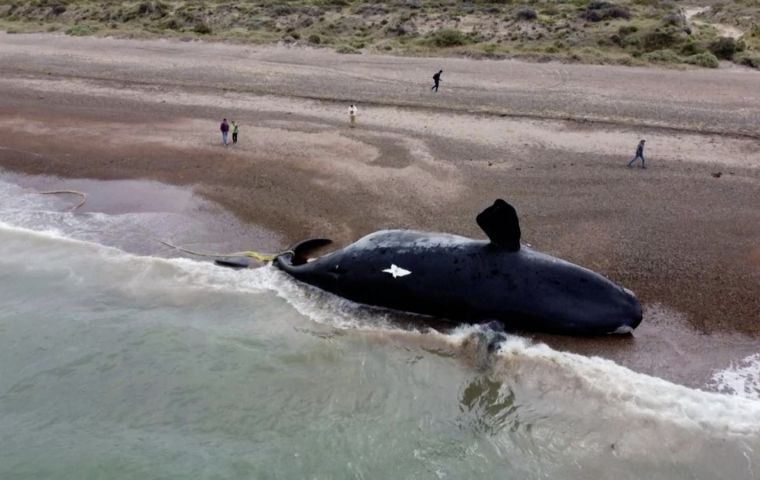MercoPress. South Atlantic News Agency
Argentine Patagonia experts determine cause of death of whales found on shores
 Red tide was behind the death of many Patagonis sea animals
Red tide was behind the death of many Patagonis sea animals Experts have determined that the cause of the recent death of 30 whales in the Valdés Peninsula, in the Argentine province of Chubut, was a harmful algal bloom also referred to as “red tide.” The findings of the dead mammals took place between late September and early October.
This cause of death was determined by researchers from the Instituto de Conservación de Ballenas (ICB) and other environmentalist groups, which also confirmed that Magellanic penguins, seabirds, and a sea lion had also died from the same cause.
Since October 10, no new whale deaths have been recorded, “which coincides with a marked decrease in the abundance of the paralytic toxin-producing species in the plankton and in the levels of biotoxins in mollusks in the New Gulf,” it was explained.
Specialists from the Southern Right Whale Sanitary Monitoring Program (PMSBFA) and the Directorate of Fauna and Flora of Chubut also confirmed the diagnoses after an extensive and thorough investigation that involved necropsies of some whales, gastrointestinal studies, and the analysis of biotoxins in samples of animal tissues, water, and bivalves.
Of the total number of specimens found dead, 26 were adults, of which 19 were female, 2 were male and the remaining 5 could not be identified.
Researchers explained that although “there are records in the world of poisoning and death of marine fauna by ingestion of the same paralyzing biotoxins that were found in the bodies of the whales that died in Peninsula Valdes”, the scarcity of studies and knowledge of these organisms, due to the fact that “they are not traditional vectors of poisoning in humans”, makes the work of the scientists more complex.
Due to “the difficulties inherent to their research, the lethal doses of biotoxins for large cetaceans, such as the southern right whale, are unknown,” they added, while underlining “the need to continue monitoring harmful algal blooms and environmental conditions in the marine environment to better understand these phenomena.”
The investigation to determine the reason for the deaths of the whales in Peninsula Valdes was carried out by the Southern Right Whale Health Monitoring Program (PMSBFA), the Whale Conservation Institute (ICB), the National Institute for Fisheries Research and Development (INIDEP), the Hydrobiology Research Institute of the National University of Patagonia San Juan Bosco and the Wildlife Directorate of Chubut.
Necropsies were not carried out on every specimen found, the ICB said in a statement. Logistical problems due to the large size of the animals or because complete forensic examinations of whales are not allowed by provincial and municipal regulations for sanitary reasons. “In some cases, the whales had to be towed to other beaches to be examined, and in others, this was not possible due to logistical limitations, as they were large animals, so necropsies were not performed.” Those studies were limited to the six whales that were best preserved.
“To date, work continues to examine the remaining eight whales, all of which were found in an advanced state of decomposition on isolated and difficult to access beaches in the Golfo Nuevo,” the doocument went on.
The whales exained had “content in the digestive tract, indicating that they had recently fed prior to their death,” the researchers said. “No specimen showed evidence of injuries or traumatic wounds that would explain their deaths,” they also concluded.
The samples of stomach and intestinal contents showed “diatoms of the species Pseudo-nitzschia australis in two specimens, cells compatible with the dinoflagellate Alexandrium catenella/tamarense complex in two whales, fragments of copepods in three, other unidentified diatoms in three, and forms compatible with unidentified dinoflagellate cells in one whale,” according to the statement. In other words, ”some diatoms Pseudo-nitzschia australis and the dinoflagellate Alexandrium catenella/tamarense complex can increase significantly during harmful algal blooms (HABs) and are potential biotoxin producers,“ while ”detectable concentrations of Mollusc Paralytic Toxin were found in five specimens.“
According to the ICB, the deaths of several Magellanic penguins and other seabirds, and of a fur seal ”with symptoms compatible with biotoxins in the New Gulf“ were also documented. The scientists collected samples from a large number of these species in order to determine if there was intoxication caused by red tide. ”Analyses to date corroborate the findings in the whales, with all animals negative for amnesic toxin, but positive for paralytic molluscan toxins in varying amounts,“ they said. And they explained that this is because ”right whales feed on copepods that act as vectors in the transfer of toxins from the base of the trophic chain, and ingest the toxins directly by filtering the microalgae found in the water“, unlike ”penguins and other marine mammals such as sea lions, which are predators and consume prey capable of bioaccumulating toxins, so in general they are exposed to higher doses”, they concluded.




Top Comments
Disclaimer & comment rulesCommenting for this story is now closed.
If you have a Facebook account, become a fan and comment on our Facebook Page!